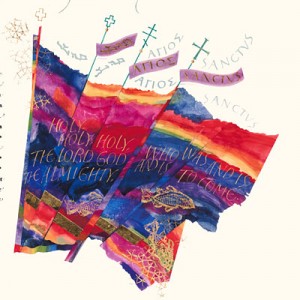On Oct. 23, the History Museum opens its doors to an exhibit that celebrates an epic achievement in the book arts. Illuminating the Word: The Saint John’s Bible features 44 pages from the first handwritten and illuminated Bible commissioned by a Benedictine monastery.

Detail from Letter to the Seven Churches with the Heavenly Choir, Donald Jackson, 2011. The Saint John's Bible, Order of Saint Benedict, Collegeville, Minnesota.
You can find out more about our exhibit here. But for now, we’d like to send out heartiest congratulations to Saint John’s Abbey and University in Collegeville, Minn., along with Donald Jackson and his team of scribes and calligraphers. On Thursday, the abbey announced that 15 years of transatlantic work had been completed, with the word “Amen” having been written on the final page of the seventh and final volume of the Bible, Letters and Revelation.
(That volume goes on exhibit today through Nov. 13 at the Minneapolis Institute of Arts.)
From the official press release:
“Today we celebrate the culmination of a fifteen year commitment to revive a monastic tradition in the modern world and create a work of art that will ignite the spiritual imagination of the world,” said Abbot John Klassen, OSB, Saint John’s Abbey. “We also celebrate the beginning of The Saint John’s Bible’s journey to inspire people from all backgrounds through the many ways they can experience the project, beginning with this exhibition at the Minneapolis Institute of Arts.” …
The Saint John’s Bible is a fifteen year collaboration of scripture scholars and theologians at Saint John’s Abbey and University in Collegeville, Minnesota with a team of artists and calligraphers at the scriptorium in Wales, United Kingdom under the direction of Donald Jackson, one of the world’s foremost calligraphers and Senior Scribe to Her Majesty Queen Elizabeth’s Crown Office at the House of Lords. Written and drawn entirely by hand using quills and paints hand-ground from precious minerals and stones such as lapis lazuli, malachite, silver, and 24-karat gold, The Saint John’s Bible celebrates the tradition of medieval manuscripts while embracing 21st century technology to facilitate the design process and collaboration between Saint John’s in Collegeville and the scriptorium in Wales.
“Now that I have inscribed the final Amen, I realise that over the long years of this task, a boyhood dream, I have gradually absorbed an enduring conviction of the pin-sharp relevance of these ancient Biblical Texts to the past, present and the future of our personal and public life and experience,” said Jackson. “These texts have a life of their own and their life is a mirror of the human spirit and experience.”
The Saint John’s Bible illustrates scripture from a modern perspective, reflecting a multicultural world and humanity’s enormous strides in science, technology and space travel, as well as recent wars and genocide. “Illuminated manuscripts have always marked the time and place in which they were created, and The Saint John’s Bible will reflect our world at the beginning of the twenty-first century for future generations,” said Fr. Robert Koopmann, OSB, President of Saint John’s University. “The illuminations in The Saint John’s Bible provide a new way for people to see and experience scripture, which is a particularly exciting in our increasingly visual culture.”
 (BTW: Donald Jackson, at left, will be in the house at the Lensic Peforming Arts Center on Nov. 7 for a 6 pm lecture. Tickets cost $15. A $50 private reception with Jackson follows. Tickets at www.ticketssantafe.org, or call 505-982-1234.)
(BTW: Donald Jackson, at left, will be in the house at the Lensic Peforming Arts Center on Nov. 7 for a 6 pm lecture. Tickets cost $15. A $50 private reception with Jackson follows. Tickets at www.ticketssantafe.org, or call 505-982-1234.)
With his fellow scribes and illuminators at a to-die-for scriptorium in Wales, Jackson carried out the monks’ request for a monumental Bible. When opened, it will measure 2′ tall by 3′ wide, with its nearly 1,150 pages bound into seven volumes. Saint John’s Abbey and University are dedicated to ecumenism, and the text, translation and imagery in The Saint John’s Bible reflect this commitment. Theologians and scholars at Saint John’s University selected the New Revised Standard Version (NRSV) as the translation for The Saint John’s Bible. Though each letter is rendered by hand, The Saint John’s Bible uses state-of-the-art computer technology to create and manage page layouts as well as employing contemporary scripts and illumination.
Illuminating the Word will share its exhibit space and spirit with Contemplative Landscape, which uses archival and contemporary black-and-white photography to reveal how people have responded to New Mexico’s art, architecture, land and sacred rituals.
